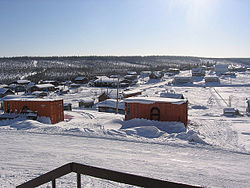Fort Good Hope
Rádeyı̨lı̨kóé Fort Hope, Fort Charles | |
|---|---|
Charter Community | |
 | |
| Coordinates: 66°15′25″N 128°38′16″W / 66.25694°N 128.63778°W | |
| Country | Canada |
| Territory | Northwest Territories |
| Region | Sahtu |
| Settlement area | Sahtu |
| Constituency | Sahtu |
| Charter Community | 1 April 1995 |
| Government | |
| • Chief | Collin Pierrot |
| • Senior Administrative Officer | Irvin Eng |
| • MLA | Daniel McNeely |
| Area | |
| • Land | 47.25 km2 (18.24 sq mi) |
| Elevation | 268 m (879 ft) |
| Population (2021)[1] | |
| • Total | 507 |
| • Density | 10.7/km2 (28/sq mi) |
| Time zone | UTC−07:00 (MST) |
| • Summer (DST) | UTC−06:00 (MDT) |
| Canadian Postal code | X0E 0H0 |
| Area code | 867 |
| Telephone exchange | 598 |
| - Living cost | 177.5A |
| - Food price index | 166.9B |
| Sources: Department of Municipal and Community Affairs,[2] Prince of Wales Northern Heritage Centre,[3] Canada Flight Supplement[4] ^A 2013 figure based on Edmonton = 100[5] ^B 2015 figure based on Yellowknife = 100[5] | |
Fort Good Hope (formerly Fort Hope, Fort Charles, also now known as the Charter Community of K'asho Got'ine[pronunciation?]), is a charter community in the Sahtu Region of the Northwest Territories, Canada. It is located on a peninsula between Jackfish Creek and the east bank of the Mackenzie River, about 145 km (90 mi) northwest of Norman Wells.
Its population is about 500, mainly indigenous. The two principal languages are North Slavey and English. Hunting and trapping are two major sources of income.
The Church of Our Lady of Good Hope, a National Historic Site, is located in the community. The church, completed in 1885, was once home to Father Émile Petitot.
- ^ a b Cite error: The named reference
2021censuswas invoked but never defined (see the help page). - ^ "NWT Communities - Fort Good Hope". Government of the Northwest Territories: Department of Municipal and Community Affairs. Retrieved 2014-01-21.
- ^ "Northwest Territories Official Community Names and Pronunciation Guide". Prince of Wales Northern Heritage Centre. Yellowknife: Education, Culture and Employment, Government of the Northwest Territories. Archived from the original on 2016-01-13. Retrieved 2016-01-13.
- ^ Canada Flight Supplement. Effective 0901Z 16 July 2020 to 0901Z 10 September 2020.
- ^ a b Fort Good Hope - Statistical Profile

